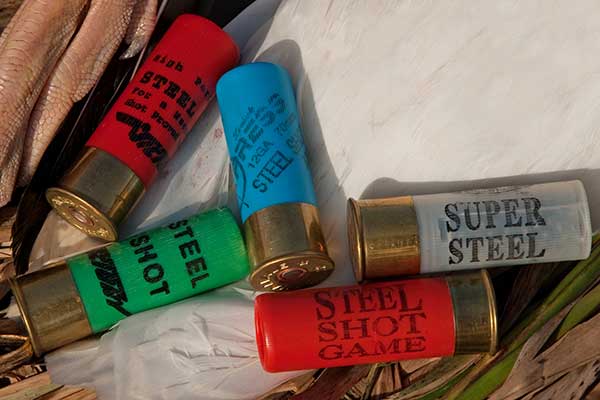
Lead ammunition consultation to launch 6 May
The Heath and Safety Executive will launch a public consultation on proposed restrictions for lead ammunition in England, Wales and Scotland.
Get information on the legal shooting season for mammals and birds in the UK.
Learn about our current conservation projects and how you can get involved.
Comprehensive information and advice from our specialist firearms team.
Everything you need to know about shotgun, rifle and airgun ammunition.
Find our up-to-date information, advice and links to government resources.
Everything you need to know on firearms law and licensing.
All the latest news and advice on general licences and how they affect you.


BASC’s head of training and education Peter Marshall summarises the findings of a new piece of research conducted by Cranfield University.
An investigation into the relative lethality of steel shot versus lead used in shotgun cartridges has indicated that, when fired into a target mimicking the physiology of a pheasant, there is little difference in pellet penetration when using recommended shot sizes.
BASC commissioned Cranfield University to investigate the lethality of steel shot versus lead, following the call by UK fieldsports organisations in February 2020 for shotgun shooters to phase out lead shot for live quarry shooting over the next five years.
The current recommendation of BASC in switching from lead to steel in shotgun ammunition is to increase the shot size by two increments. Therefore, in this trial, we compared a top-end manufacturer’s No.5 (2.8mm) lead shot load with a standard steel load of No.3 (3.3mm).
The lethality assessment was carried out by Stephen Champion, Cranfield University’s head of lethality studies, and his team under the guidance of BASC and the Gun Trade Association.
The study utilised ballistic gelatine with and without pheasant skin and feathers on the front layer. It also briefly looked at the patterning and velocity of loads.
The question is whether the increased drag in both air and target due to the increase in the area of individual shot (6.1mm2 for lead vs 9.24mm2 for steel) will reduce the lethality of the shot. This is balanced against the increase in weight of the No.3 steel shot (0.42g) compared to the No.5 lead shot (0.33g).
Theoretically, the higher areal density* of the lead shot (0.054/mm2) compared with steel (0.045g/mm2) should give a 16% advantage to lead shot, all other things being equal. However, this is a rather crude comparison and the only way to test the theory is to physically replicate it in the field.
The experiment was carried out using a commercially available over-and-under shotgun with nominal half choke and fired at ranges from 30 – 50 yards into 35 x 1kg blocks of 10% gelatine.
On bare ballistic gelatine blocks, the lead shot penetrated on average 10mm deeper than the steel equivalent, as can be seen from Table 1.
Comparison of a high-end game cartridge of No.5 lead shot compared to a standard steel load of No.3 shot.
| Load | Average depth of penetration at 30 yards | Average depth of penetration at 40 yards | Average depth of penetration at 50 yards |
| High-end lead load 32g No.5 shot | 94.8mm | 82.8mm | 66.4mm |
| Standard steel 32g No.3 shot | 85.9mm | 67.4mm | 58.9mm |
This is illustrated in Plates 1 and 2, where we can see that the lead is penetrating slightly further than the steel shot at 40 yards. The interesting thing to note is that the lead has a greater variability in its penetration compared to the steel, which consistently penetrates to about the same distance. When the pellets were extracted from the gelatine, it was observed that the steel pellets were nearly all still spherical whereas all the lead pellets had some form of deformation, which might account for their variability in penetration.
We then covered the blocks of gelatine with a single layer of skin and feathers from the breast of a pheasant and repeated the test at 40 and 50 yards. The results can be seen in Table 2 below.
Comparison of the penetration into ballistic gelatine covered with skin and feathers of pheasant breast.
| Load | Average depth of penetration at 40 yards | Average depth of penetration at 50 yards |
| High-end lead load 32g No.5 shot | 48.4mm | 33.2mm |
| Standard steel 32g No.3 shot | 52.0mm | 28.3mm |
Table 2 shows that at 40 yards the steel pellets penetrated on average 4mm further than the lead equivalents. At 50 yards, the lead pellets penetrated on average a little further than the steel pellets. In the opinion of Stephen Champion from Cranfield University, both pellet types still had the penetrative energy to consistently kill pheasant-sized quarry at both these ranges if there was a sufficient pattern.
Plates 3 and 4 show the penetration of lead No.5 compared with that of steel No.3. The plates clearly show that feathers are being dragged into the gelatine blocks by the pellets of both lead and steel.
I’m sure if you have ever dressed a bird you would notice feathers in the meat, and you will have found pellets in the meat surrounded by a small ball of feathers.
Some of the lead pellets were really held back by the skin and feathers while others were not. The steel pellets, being more uniform in shape, seemed on average to be less affected and therefore penetrated further at this range.
The study also looked at the penetration of shot across the pattern and found no real difference in the penetration of steel pellets in the centre of the pattern compared to the edge.
Measurement of the muzzle velocity of the shot showed that the lead loads were on average slightly faster (1,253 ft/sec) than the steel loads (1,240 ft/sec).
Some of the lead pellets were really held back by the skin and feathers while others were not. The steel pellets, being more uniform in shape, seemed on average to be less affected and therefore penetrated further at this range.
Key finding from the Cranfield University study Tweet
When comparing No.3 standard steel and No.5 lead shot, the lead shot consistently penetrates on average 10mm deeper than the steel equivalent against bare gelatine blocks. However, when pheasant skin and feathers are applied to the face of the gelatine, any consistent preference for lead over steel in terms of penetration disappears.
When concerned with lethality to pheasants, at the maximum range tested (50 yards) the average penetration of both steel No.3 and lead No.5 was approximately 30mm into the gelatine after penetrating the skin and feathers. Therefore, at least up to 50 yards, the lethality of the shot is more a matter of patterning rather than penetration capability.
Certainly, the patterns observed would be capable of consistently killing pheasant-sized quarry at 40 yards and up to 50 yards would be a matter of pattern rather than penetration.
There is also some evidence that No.3 steel shot does not have any advantage over No.4 steel shot in terms of penetration against bare gelatine; therefore, considering the increase in the number of pellets, the smaller shot size may be a preferred choice. But this test was with a small number of cartridges and can be best described as an indication rather than a solid conclusion.
This article first appeared in the November/December issue of Shooting and Conservation magazine.
*Areal density is defined as the weight over the presented area and is a common measure in assisting in the analysis of penetration mechanics, the other one being “Kinetic Energy Density” which is similarly an area based term, but requires prior knowledge of velocity.
In addition to the testing Cranfield University has conducted on penetration, we also want to look at various other areas where answers are needed.
Testing pre-1954 non-nitro-proofed guns with steel shot is high on the agenda. We have already performed some preliminary studies into this area, but more testing is required to give guidance.
Testing new sustainable ammunition as it appears on the market will also be a priority.
We want to look at the capability of high-performance sustainable ammunition compared to standard steel and lead shot.
We will continue to test Damascus-barrelled guns and see how they perform with the new loads being developed so we can offer accurate guidance.

The Heath and Safety Executive will launch a public consultation on proposed restrictions for lead ammunition in England, Wales and Scotland.

Neil Morrison examines the ballistic properties of steel shot and advises how to get the best results when using it to shoot wildfowl.

Our friends from overseas provide an insight into how hunters in their countries have adapted to using non-lead ammunition.
Sign up to our weekly newsletter and get all the latest updates straight to your inbox.
© 2023 British Association for Shooting and Conservation. Registered Office: Marford Mill, Rossett, Wrexham, LL12 0HL – Registered Society No: 28488R. BASC is a trading name of the British Association for Shooting and Conservation Limited which is authorised and regulated by the Financial Conduct Authority (FCA) under firm reference number 311937.
If you have any questions or complaints about your BASC membership insurance cover, please email us. More information about resolving complaints can be found on the FCA website or on the EU ODR platform.
This website uses cookies so that we can provide you with the best user experience possible. Cookie information is stored in your browser and performs functions such as recognising you when you return to our website and helping our team to understand which sections of the website you find most interesting and useful.
Strictly Necessary Cookie should be enabled at all times so that we can save your preferences for cookie settings.
If you disable this cookie, we will not be able to save your preferences. This means that every time you visit this website you will need to enable or disable cookies again.
This website uses Google Analytics to collect anonymous information such as the number of visitors to the site, and the most popular pages.
Keeping this cookie enabled helps us to improve our website.
Please enable Strictly Necessary Cookies first so that we can save your preferences!
More information about our Cookie Policy